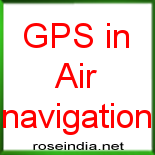GPS in Air navigation
Global Positioning System or GPS is now the principal navigation system that provides location of any object on the earth with accuracy. It is also used in shipping, automobile and other industries for navigational purposes. As far as the aviation industry is concerned GPS is used for both visual navigation and normal object guidance when it becomes impossible for pilot to locate the destinations’ position due to bad weather or at night. Anyhow GPS assists the pilot in landing airplanes at the exact location, as it requires maximum accuracy.
As we have already discussed in some of our previous articles that there are 24 satellites covering earth in 6 orbital planes providing transmits signals that consists of satellite position, time and data on the basis of which the location of an object is determined in respect to its longitude and latitude coordinates.
GPS satellites are arranged in such a way that every GPS receivers can determine the position of 5 satellites from anywhere on the earth. Usually navigation in road or shipping requires at least four satellite’s positions and status data. However, in case of air navigation that requires accurate positioning especially for landing on to airports, five satellites are needed.
The satellites broadcast signals containing its position details at particular time and the GPS receiver after getting the signals analyzes all details and then determines the location of the satellite. Then following triangulation method the airplane position is determined. This can generate an error of up to 200 feet but the Military uses the more developed one known as the Precision Positioning Service (PPS) enable with an utmost accuracy. This is possible due to the atomic clock and other scientific advances.
Typically, one airplane fly from one point to another and hence by storing the co-ordinate points of the destination, the flight can be directed easily. So with an advanced GPS system airplane can easily be landed no matter what the weather condition is. So a GPS in the cockpit provides accurate position data to the pilot and helps him keeping the airplane on track.
Benefits of GPS in Aviation Industry:
The use of GPS in guiding airplanes has been proved beneficial to the aviation industry in many ways. Better accuracy in landing enhanced flight safety and better navigation service from one point to another. This further helps in preparing a proper time-by-time flight schedule and thereby decrease unnecessary travel and fuel consumption. The direct access of GPS signals and then determining the exact coordinates of the destination significantly reduced the ground based operational and maintenance cost. The GPS receivers used for normal navigation does not hold that much of accuracy where as the WAAS enabled receiver provide accuracy to that level which the ground based equipment can not do that.



